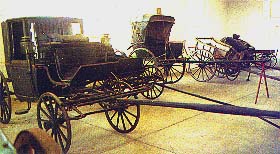|
|
 |
 |
|
The Wagonmakers' Museum |
 |
 |
|
The role of the wagon making industry in the development of Paarl as an in-
dustrial center can never be ignored, even if the industry today is but a faded memory. The industry had its origins in a number of one-man workshops |
 |
 |
|
West Africa, (Namibia) and even from aboard. During the Anglo Boer War and the military campaign of the Union of South Africa in German South West Africa a few years later, the factories had to work around the clock to keep up with orders. |
 |
 |
 |
 |
|
Ancillary undertakings such as harness making supported the industry and la-
ter the renowned and "flashy" Cape carts, tented carts unique to South Africa were also manufactured here. Trainloads of wagons and carts were often dispatched from Huguenot Station, one of the first railway stations in the country. |
|
|
After 1914, with the advent of the motor car and compulsory reduction in working hours for factory workers, the wagon making industry declined ra-
pidly. The glory of those romantic days can however be recalled today by visiting Paarl's Wagonmaker's Museum.
This young museum is housed in a spacious building and good progress has been made with the collection of antiques from this once florishing pioneering industry. A considerable number of wagons and carts, as well as the ne-
cessary wagonmaking equipment and tools, have already been assembled. Work continues unabated on the restoration of the items and the building. |
|
|
Back to Paarl |
|
|


